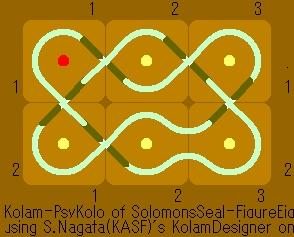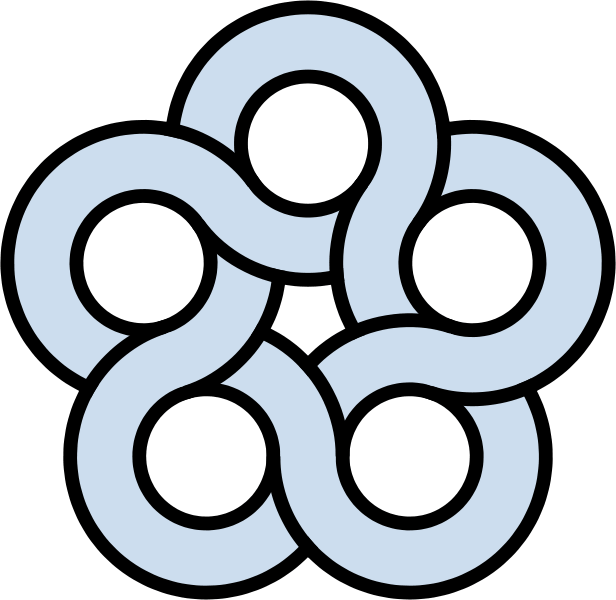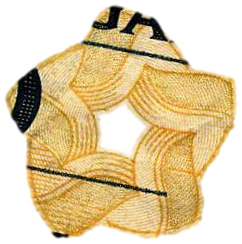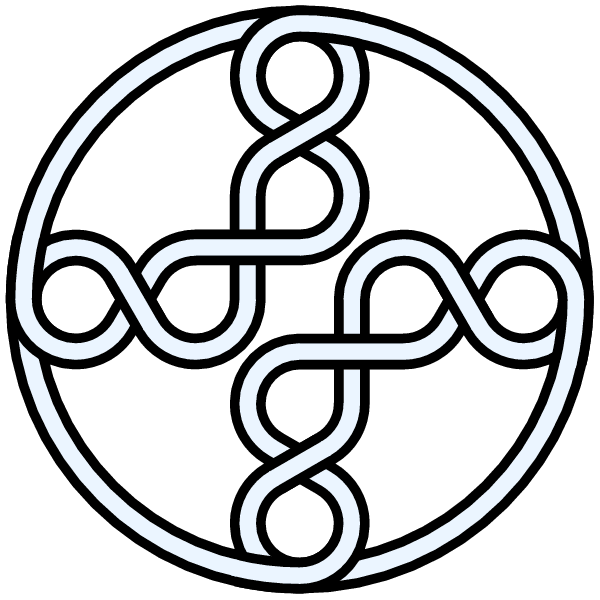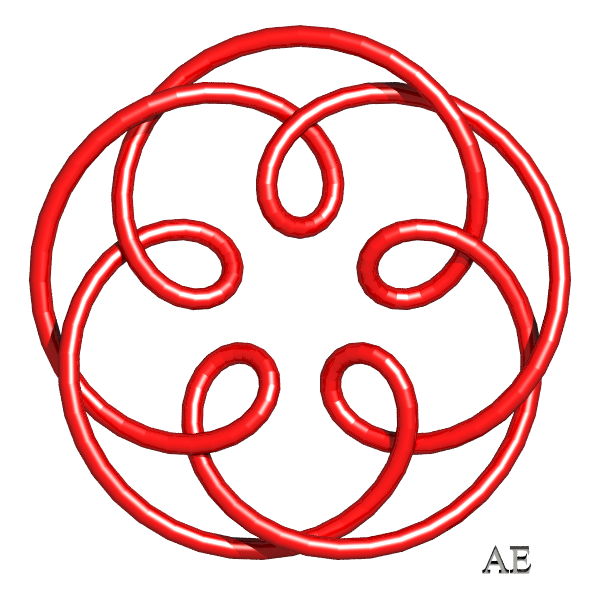T(5,2)
|
|
|

|
Visit [[[:Template:KnotilusURL]] T(5,2)'s page] at Knotilus!
Visit T(5,2)'s page at the original Knot Atlas! |
| An interlaced pentagram, this is known variously as the "Cinquefoil Knot", after certain herbs and shrubs of the rose family which have 5-lobed leaves and 5-petaled flowers (see e.g. [4]),
as the "Pentafoil Knot" (visit Bert Jagers' pentafoil page), as the "Double Overhand Knot", as 5_1, or finally as the torus knot T(5,2). When taken off the post the strangle knot (hitch) of practical knot tying deforms to 5_1 |
 The VISA Interlink Logo [1] |
 Version of the US bicentennial emblem | |
 A pentagonal table by Bob Mackay [2] |
||
 Partial view of US bicentennial logo on a shirt seen in Lisboa [3] | ||
This sentence was last edited by Dror. Sometime later, Scott added this sentence.
Knot presentations
| Planar diagram presentation | X3948 X9,5,10,4 X5,1,6,10 X1726 X7382 |
| Gauss code | -4, 5, -1, 2, -3, 4, -5, 1, -2, 3 |
| Dowker-Thistlethwaite code | 6 8 10 2 4 |
| Conway Notation | Data:T(5,2)/Conway Notation |
Polynomial invariants
KnotTheory`, as shown in the (simulated) Mathematica session below. Your input (in red) is realistic; all else should have the same content as in a real mathematica session, but with different formatting. This Mathematica session is also available (albeit only for the knot 5_2) as the notebook PolynomialInvariantsSession.nb.
(The path below may be different on your system, and possibly also the KnotTheory` date)
In[1]:=
|
AppendTo[$Path, "C:/drorbn/projects/KAtlas/"];
<< KnotTheory`
|
Loading KnotTheory` version of August 31, 2006, 11:25:27.5625.
|
In[3]:=
|
K = Knot["T(5,2)"];
|
In[4]:=
|
Alexander[K][t]
|
KnotTheory::loading: Loading precomputed data in PD4Knots`.
|
Out[4]=
|
In[5]:=
|
Conway[K][z]
|
Out[5]=
|
In[6]:=
|
Alexander[K, 2][t]
|
KnotTheory::credits: The program Alexander[K, r] to compute Alexander ideals was written by Jana Archibald at the University of Toronto in the summer of 2005.
|
Out[6]=
|
In[7]:=
|
{KnotDet[K], KnotSignature[K]}
|
Out[7]=
|
{ 5, 4 } |
In[8]:=
|
Jones[K][q]
|
KnotTheory::loading: Loading precomputed data in Jones4Knots`.
|
Out[8]=
|
In[9]:=
|
HOMFLYPT[K][a, z]
|
KnotTheory::credits: The HOMFLYPT program was written by Scott Morrison.
|
Out[9]=
|
In[10]:=
|
Kauffman[K][a, z]
|
KnotTheory::loading: Loading precomputed data in Kauffman4Knots`.
|
Out[10]=
|
Vassiliev invariants
| V2 and V3: | (3, 5) |
| V2,1 through V6,9: |
|
V2,1 through V6,9 were provided by Petr Dunin-Barkowski <barkovs@itep.ru>, Andrey Smirnov <asmirnov@itep.ru>, and Alexei Sleptsov <sleptsov@itep.ru> and uploaded on October 2010 by User:Drorbn. Note that they are normalized differently than V2 and V3.
Khovanov Homology
| The coefficients of the monomials are shown, along with their alternating sums (fixed , alternation over ). The squares with yellow highlighting are those on the "critical diagonals", where or , where 4 is the signature of T(5,2). Nonzero entries off the critical diagonals (if any exist) are highlighted in red. |
|
| Integral Khovanov Homology
(db, data source) |
|
Computer Talk
Much of the above data can be recomputed by Mathematica using the package KnotTheory`. See A Sample KnotTheory` Session.
In[1]:= |
<< KnotTheory` |
Loading KnotTheory` (version of August 17, 2005, 14:44:34)... | |
In[2]:= | Crossings[TorusKnot[5, 2]] |
Out[2]= | 5 |
In[3]:= | PD[TorusKnot[5, 2]] |
Out[3]= | PD[X[3, 9, 4, 8], X[9, 5, 10, 4], X[5, 1, 6, 10], X[1, 7, 2, 6], X[7, 3, 8, 2]] |
In[4]:= | GaussCode[TorusKnot[5, 2]] |
Out[4]= | GaussCode[-4, 5, -1, 2, -3, 4, -5, 1, -2, 3] |
In[5]:= | BR[TorusKnot[5, 2]] |
Out[5]= | BR[2, {1, 1, 1, 1, 1}] |
In[6]:= | alex = Alexander[TorusKnot[5, 2]][t] |
Out[6]= | -2 1 2 |
In[7]:= | Conway[TorusKnot[5, 2]][z] |
Out[7]= | 2 4 1 + 3 z + z |
In[8]:= | Select[AllKnots[], (alex === Alexander[#][t])&] |
Out[8]= | {Knot[5, 1], Knot[10, 132]} |
In[9]:= | {KnotDet[TorusKnot[5, 2]], KnotSignature[TorusKnot[5, 2]]} |
Out[9]= | {5, 4} |
In[10]:= | J=Jones[TorusKnot[5, 2]][q] |
Out[10]= | 2 4 5 6 7 q + q - q + q - q |
In[11]:= | Select[AllKnots[], (J === Jones[#][q] || (J /. q-> 1/q) === Jones[#][q])&] |
Out[11]= | {Knot[5, 1], Knot[10, 132]} |
In[12]:= | A2Invariant[TorusKnot[5, 2]][q] |
Out[12]= | 6 8 10 12 14 18 20 22 q + q + 2 q + q + q - q - q - q |
In[13]:= | Kauffman[TorusKnot[5, 2]][a, z] |
Out[13]= | 2 2 2 3 3 4 4 |
In[14]:= | {Vassiliev[2][TorusKnot[5, 2]], Vassiliev[3][TorusKnot[5, 2]]} |
Out[14]= | {0, 5} |
In[15]:= | Kh[TorusKnot[5, 2]][q, t] |
Out[15]= | 3 5 2 7 3 11 4 11 |


